» important discoveries that influenced the development of electrics.
Topic: what was the first electricity, the most important discoveries, its development.
This topic will provide a short overview of the most significant discoveries that relate to the field of knowledge about electricity. It was they who once fundamentally influenced the further development of this science as a whole.
First, I would like to remind you that the concept of electricity is a kind of description of certain properties of the manifestation of matter in the form of existing energies (charges elementary particles and their relationship with other properties of matter). It was invented by the English Tudor scholar William Gilbert. As philosophy says, matter is eternal (temporary is only a form of its manifestation). It follows from this that electricity was, is and will always be, which means that it will not happen for the first time. For the first time there can be only human knowledge itself, these manifestations, through observations, experiments, discoveries. And, therefore, the history of these events will be considered the general history of all electricity.
Thales of Miletus was one of the first to become interested in electric charge. He noticed that amber, rubbed on a woolen cloth, acquires the ability to attract small and light particles to itself. It was once even used to dust various surfaces. It was assumed that only amber had such properties. After physics began to be considered an experimental science, this phenomenon was more studied.
The first such electricity, in the sense of scientific achievements, can be considered those studies that began to be carried out around the beginning of the 17th century. They belong to the physicist William Gilbert. With the help of his electroscope, he demonstrated that not only amber can attract light bodies (like a piece of paper or a straw) to itself. These properties are also possessed by materials such as sapphire, diamond, rock crystal, glass and others. He was one of the first to start researching magnetic phenomena, albeit superficially.
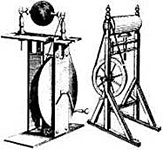 Research into charged particles and static electricity eventually gave birth to the first electrostatic machine. It had a primitive design, but was quite capable of generating electricity by rubbing against a ball made of natural sulfur. During its operation, discharges arose at a short distance. It was in 1650. The name of the scientist was Otto von Guericke. By and large, the machine did not have much use for practical use.
Research into charged particles and static electricity eventually gave birth to the first electrostatic machine. It had a primitive design, but was quite capable of generating electricity by rubbing against a ball made of natural sulfur. During its operation, discharges arose at a short distance. It was in 1650. The name of the scientist was Otto von Guericke. By and large, the machine did not have much use for practical use.
In the early 18th century, Stephen Gray noticed that some substances (namely, this applies to metals) have the ability to conduct electricity through themselves. A little later, Robert Simmer, looking at the electrification of silk things, concluded that electricity has two opposites. The properties themselves began to be called "charges". Moreover, they were defined as positive and negative.
The essence of their appearance is redistribution during the friction of bodies against each other. And this already contributes to the electrification of such bodies. That is, electrization is something other than the accumulation of a certain type of charge on the body itself. In addition, charges of the same kind will repel each other, and charges of the opposite value will mutually attract. Charles Dufay came to similar judgments in 1829. His experiments showed that one of the types of charge appears as a result of friction of glass on silk, the other, when resin is rubbed on wool. In honor of this, the scientist gave them names - "glass" and "resin" charge.
In 1785, Charles Coulomb experimentally established the law of interaction of charges. With the help of special accurate scales (developed by him) - he found out that the interaction force that occurs between electrically charged bodies is inversely proportional to the square of the path between them. Thus, the science of electricity began to be attributed to the exact sciences, in which it is possible to apply mathematical methods for calculations.
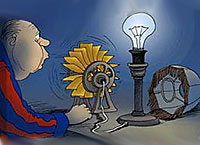 In 1821, Ampère and Oersted discovered a direct connection between magnetism and electrical phenomena. In 1830, Gauss expresses the fundamental theory of the electrostatic field. And already in 1831, Michael Faraday discovered electromagnetic induction and the principles of electrolysis. Introduces the concepts of electrical and magnetic field. In 1880, Lachinov demonstrated the essence of the transfer of electrical energy to long distances. In 1888, Heinrich Hertz discovered electromagnetic waves.
In 1821, Ampère and Oersted discovered a direct connection between magnetism and electrical phenomena. In 1830, Gauss expresses the fundamental theory of the electrostatic field. And already in 1831, Michael Faraday discovered electromagnetic induction and the principles of electrolysis. Introduces the concepts of electrical and magnetic field. In 1880, Lachinov demonstrated the essence of the transfer of electrical energy to long distances. In 1888, Heinrich Hertz discovered electromagnetic waves.
As a result, the electrical theory of matter was created. It said that physical bodies are complexes of interacting various particles and elements. They have electric charges, and most of the properties of various physical bodies can be described by existing laws. All this made it possible to use electricity in almost all spheres of human life, facilitating its work and bringing convenience.
P.S. Oddly enough, but in our world there is such a circumstance: the presence of all the properties (manifestations) of the universe is unlimited and eternal (electricity, as a special case), and human knowledge about this is insignificant and, what is even more interesting, short-lived. It is worth losing the memory of the accumulated knowledge, as everything will have to be discovered from the beginning. An example is previous civilizations that have already ceased to exist.
Now without electricity it is not possible to imagine our life.
The invention of electricity accelerated the development of mankind and made our life much easier and more comfortable. But once there was no electricity, and people did without this amazing power. It seems to us that this “dark” era was a very long time ago. But in fact, in our country, or rather in most of it, there was no electricity, only 100 – 70 years ago!
The effect of electricity, or rather the attraction of light objects, was of interest to people even before our era. But for the first time the term electricity appeared in 1600, when the English naturalist William Gilbert described in his writings experiments with electrified bodies.
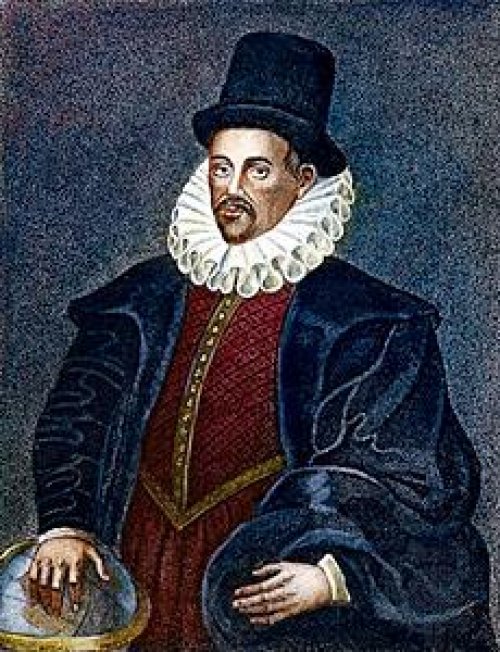
Then many scientists, whose names are now named various properties of electricity, contributed to the process of curbing and using this force in the service of mankind. Faraday, Hertz, Amp, Joule, Ohm, Volt
and many other physicists and scientists have contributed to this process.
In our country, in the 20s, and even in the 30s, of the twentieth century, electricity was far from being everywhere. “ Lamp of Ilyich”, this expression speaks perfectly about the years of the beginning of the development of electricity in our country.
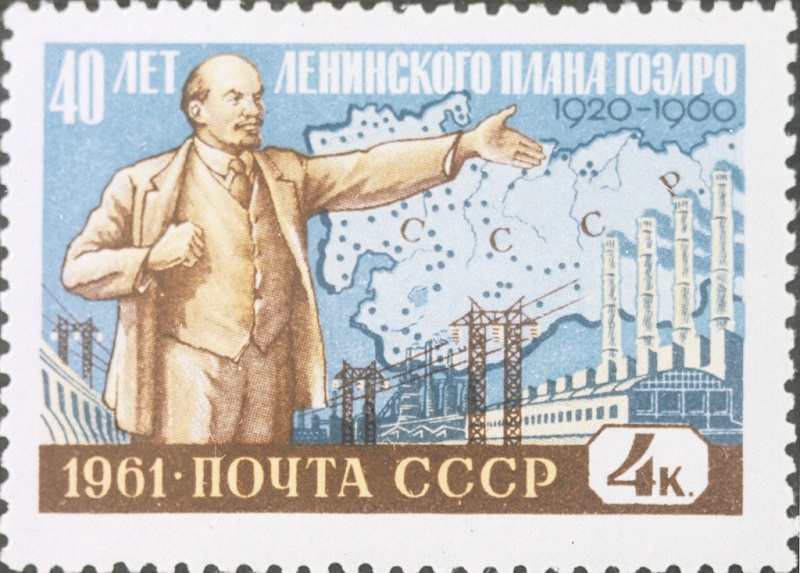
First of all, electricity appeared in large cities: Kyiv, Moscow, St. Petersburg. This is in St. Petersburg and Moscow, electricity appeared at the end of the 19th century. In St. Petersburg in 1879, the Foundry Bridge was lit for the first time in the world with electricity! And in Moscow in 1883, the illumination of the Kremlin was created. In the summer of 1893, the first tram in Russia ran along the rails in Kyiv. The length of the first tram line was only 1.5 km, and the power of the power plant that fed it was 30 kW. The development of electrification in our country took more than a dozen years. Of course, last but not least, electrification reached distant regions, villages and villages. For example, in the Sverdlovsk region, by the age of 50, only 72% of collective farms were equipped with electricity.
![]()
But the most interesting and surprising thing is that even today, in 2015, in our digital and high-tech world, about a billion people do not have electricity! This is the data of the World Bank, the information is taken from Wikipedia.
If your company needs industrial equipment, pay attention to NPO SD Technogress http://sd-tehno.ru. The company provides plants and factories with industrial equipment: pumps, machine tools, pneumatic and hydraulic equipment, engines, gearboxes, couplings and other industrial equipment. The company supplies and installs equipment in Russia and the CIS.
It is difficult for a modern person to imagine life without electricity. It has firmly entered our lives, and we think little about when it appeared. But it was thanks to electricity that all areas of science and technology began to develop more intensively. Who invented electricity when it first appeared in the world?
History of occurrence
Even before our era Greek philosopher Thales noticed that after rubbing amber on wool, small objects are attracted to the stone. Then no one was engaged in the study of such phenomena for a long time. Only in the 17th century, having studied magnets and their properties, the English scientist William Gilberg introduced the new term "electricity". Scientists began to show more interest in it and engage in research in this area.
Gilberg managed to invent the prototype of the very first electroscope, it was called a versor. With the help of this device, he established that, in addition to amber and other stones, small objects can attract to themselves. . The stones include:
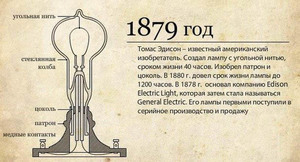
Thanks to the created device, the scientist was able to conduct several experiments and draw conclusions. He realized that the flame has the ability to seriously affect the electrical properties of bodies after friction. The scientist stated that Thunder and lightning- phenomena of an electrical nature.
Great discoveries
The first experiments on the transmission of electricity over short distances were carried out in 1729. Scientists concluded that not all bodies can transmit electricity. A few years after a series of tests, the Frenchman Charles Dufay stated that there are two types of electric charge − glass and resin. They depend on the material that is used for friction.
Then scientists with different countries a capacitor and a galvanic cell, the first electroscope, and a medical electrocardiograph were created. The first incandescent light bulb appeared in 1809, which was created by the Englishman Delarue. 100 years later, Earnwing Langmuir developed a light bulb with a tungsten filament filled with an inert gas.
There were many very important discoveries in the 19th century, thanks to which electricity appeared in the world

They studied the properties of electricity and many of them are named after them. At the end of the 19th century, physicists make discoveries about the existence of electric waves. They manage to create an incandescent lamp and transmit electrical energy long distances. From that moment on, electricity slowly but surely begins to spread throughout the planet.
When did electricity appear in Russia?
If we talk about electrification in the territory Russian Empire, then in this question no specific date. Everyone knows that in 1879 in St. Petersburg they made lighting throughout the Liteiny Bridge. It was lit with lamps. However, in Kyiv, electric lights were installed in one of the railway workshops a year earlier. This event did not attract attention, so 1879 is considered the official date for the appearance of electric lighting in the Russian Empire.
The first electrical department appeared in Russia on January 30, 1880 in the Russian Technical Society. The department was obliged to supervise the introduction of electricity in everyday life states. As early as 1881, Tsarskoe Selo was a fully illuminated settlement and became the first modern and European city.
May 15, 1883 It is also considered a landmark date for the country. This is due to the illumination of the Kremlin. At this time, Emperor Alexander III came to the throne, and the illumination was timed to coincide with such an important event. Almost immediately after this historic event, lighting was carried out first on the main street and then to the Winter Palace of St. Petersburg.
By decree of the emperor in 1886, the "Electric Lighting Society" was established. His duties included lighting the two main cities - Moscow and St. Petersburg. Two years later, the construction of power plants began in all major cities. The first electric tram in Russia was launched in 1892. In St. Petersburg, after 4 years, the first hydroelectric power station was put into operation. It was built on the Bolshaya Okhta River.
An important event was the appearance of the first power plant in Moscow in 1897. It was built on the Raushskaya embankment with the ability to generate alternating three-phase current. She made it possible to transmit electricity over long distances and use it without losing power. The construction of power plants in other Russian cities began to develop only before the First World War.
Interesting facts about the history of the appearance of electricity in Russia
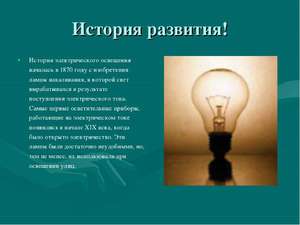 If you carefully study some facts of electrification Russian state you can find out a lot of interesting information.
If you carefully study some facts of electrification Russian state you can find out a lot of interesting information.
The first incandescent light bulb with a carbon rod was invented in 1874 by A.N. Lodygin. The device was patented by the largest European countries. After a while, it was improved by T. Edison and the light bulb began to be used all over the planet.
Russian electrical engineer P.N. Yablochkov completed development in 1876 electric candle. It has become simpler, cheaper and more convenient than Lodygin's light bulb in operation.
As part of the Russian Technical Society, a Special Electrotechnical Department was created. It included P.N. Yablochkov, A.N. Lodygin, V.N. Chikolev and other active physicists and electrical engineers. The main task of the department was to promote the development of electrical engineering in Russia.
Supporters of alternative versions of history no longer know what to complain about: o)
This time, pictures of Byrd's factory served as such an occasion.
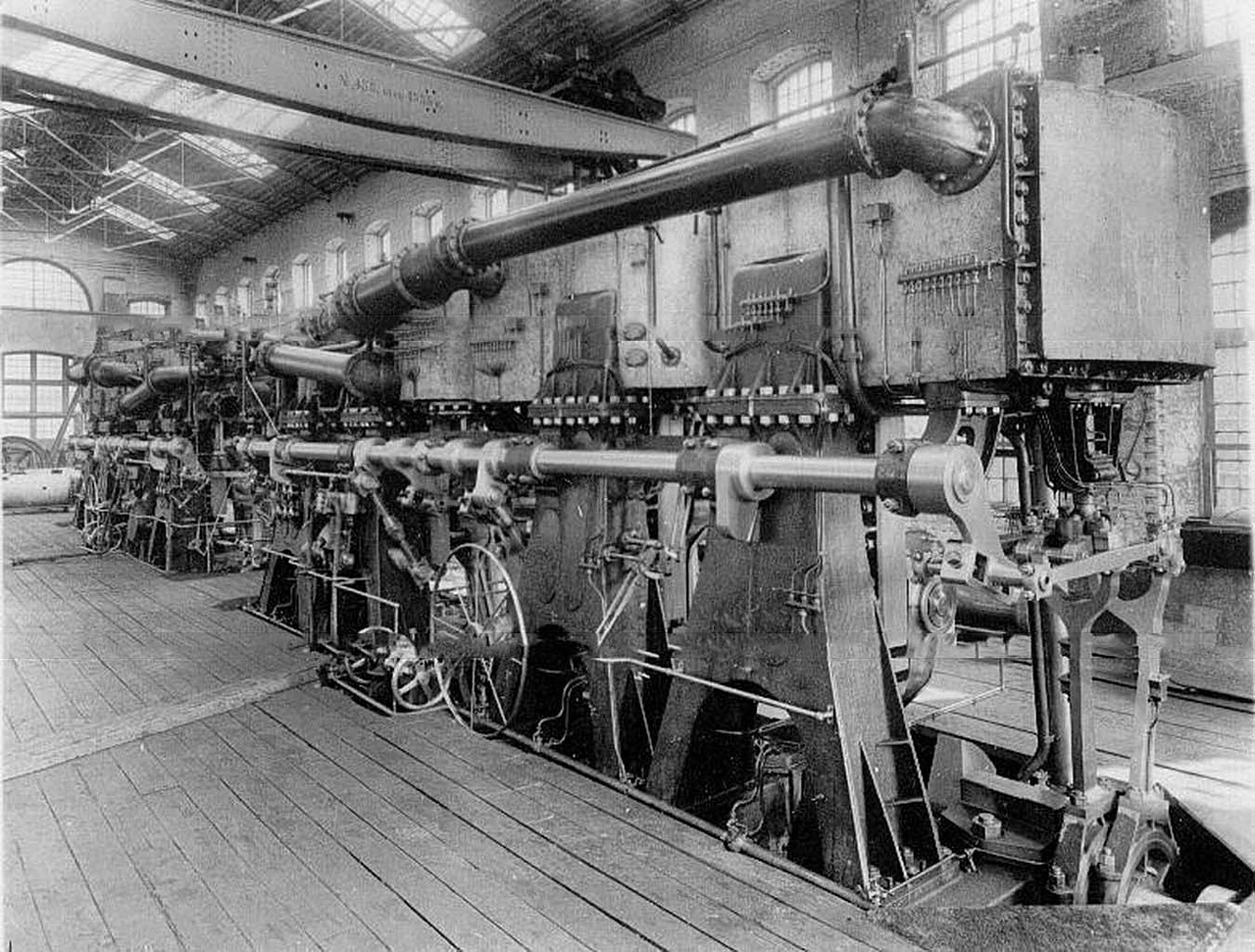

I believe that such an unknowing person is not alone, therefore I quote part of the article from here:
relating only to the 19th century
A.N. Lodygin received a patent for the invention of an incandescent lamp with a carbon rod (privilege No. 1619 dated July 11, 1874) and the annual Lomonosov Prize of the Academy of Sciences. The device was also patented in Belgium, France, Great Britain, Austria-Hungary. Six years later, in 1880, electric lamp Lodygina, improved by T. Edison, began her triumphal march around the planet.
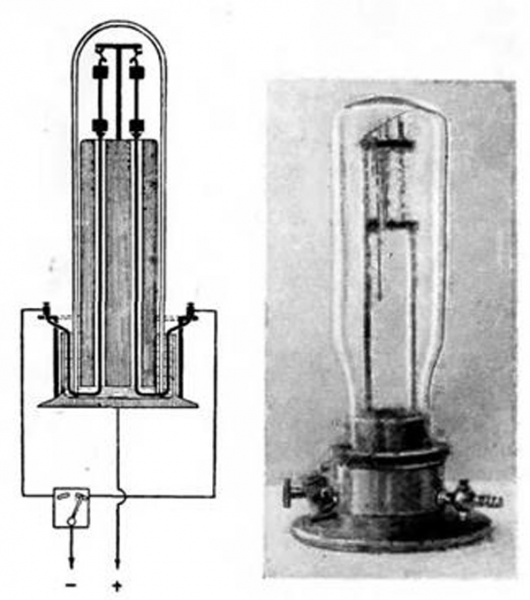
Electric incandescent lamp Lodygin
Russian electrical engineer P.N. Yablochkov, at his small electrical engineering enterprise, built the first differential lamp designed by V. N. Chikolev. The Chikolev lamp operated from the first moment without manual adjustment, required a relatively small current and allowed an arbitrary number of lamps to be connected in series in a circuit. Since 1879, the idea of a differential controller by V.N. Chikoleva received wide application in projector construction.
Engineer F.A. Pirotsky conducted a series of experiments on the transmission of electricity over a distance of first several tens of meters, and then up to 1 km. Based on the experiments, he came to the conclusion that it is possible to transmit electricity over long distances.
P.N. Yablochkov completed the development of the design of an electric candle, which began in 1875, and on March 23, 1876 received French patent No. 112024 containing short description candles in their original forms and the image of these forms. "Yablochkov's Candle" turned out to be simpler, more convenient and cheaper to operate than A.N. Lodygin. Under the name "Russian light", Yablochkov's candles were later used for street lighting in many cities around the world. Yablochkov also proposed the first practically used AC transformers with an open magnetic system.
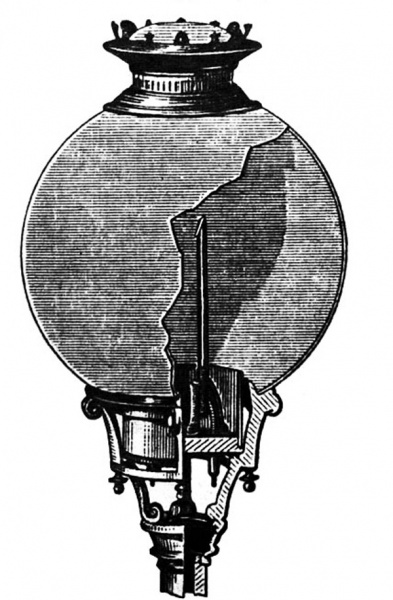
Electric lamp Yablochkov
1879
Russian electrical engineers P.N. Yablochkov, A.N. Lodygin, V.N. Chikolev, together with a number of other electrical engineers and physicists, organized a Special Electrotechnical Department within the Russian Technical Society. The task of the department was to promote the development of electrical engineering.
In April 1879, for the first time in Russia, a bridge was illuminated with electric lights - the bridge of Alexander II (now Liteyny Bridge)
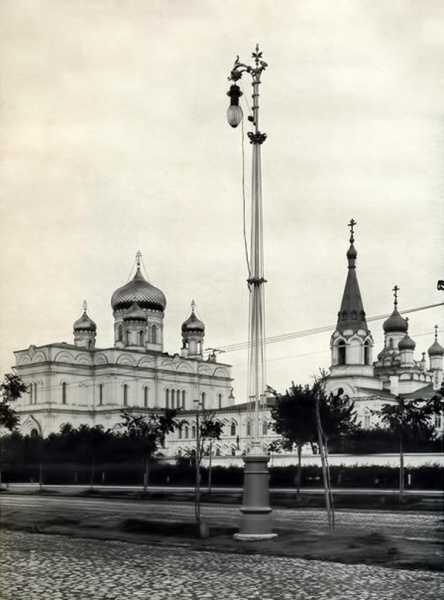
One of the first electric lights
in St. Petersburg. With the assistance of the Department, the first in Russia installation of outdoor electric lighting (with Yablochkov arc lamps in lamps designed by the architect Kavos) was introduced on Liteiny Bridge, which marked the beginning of the creation of local lighting systems with arc lamps for some public buildings in St. Petersburg, Moscow and other large cities. Electric lighting of the bridge arranged by V.N. Chikolev, where 12 Yablochkov candles burned instead of 112 gas jets, functioned for only 227 days.
On January 30, the world's first special electrotechnical society was created - the VI department of the Russian Technical Society, designed to oversee the problems of electrification in Russia.
In March, the world's first electrical exhibition opened at the premises of the Russian Technical Society in Salt Town in St. Petersburg. The purpose of the exhibition was to “show the public state of the art development various industries electrical engineering".
In July, one of the first electrical engineering magazines in the world, the Electricity magazine, began to be published. F. Pirotsky modernizes the city's horse-drawn double-decker trams, converting them to electric traction. On August 22 at 12 noon in St. Petersburg, at the corner of Bolotnaya Street and Degtyarny Lane, for the first time in Russia, the possibility of moving a tram car was tested "by electric force running along the rails along which the wheels of the car roll."
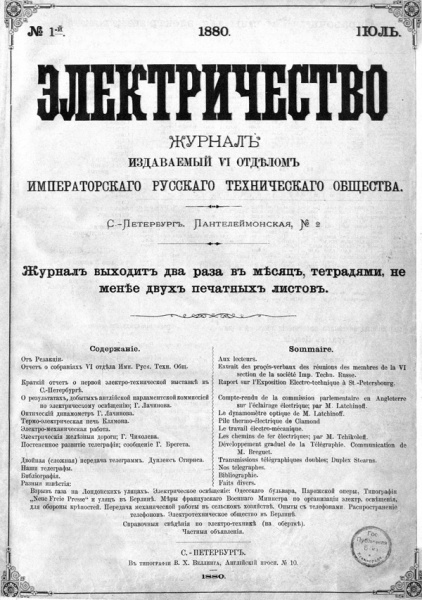
Cover of the first issue of the Electricity magazine. July 1880
The Association "Electrotechnician" was organized. This Partnership arranged electric arc lighting in gardens and public institutions, using mainly Chikolev differential lamps, and built small private power plants. In 1880, the Partnership announced that it would take over the installation of electric lighting for stations, railways, printing houses, factories and workshops, hotels, restaurants, shops, clubs, theaters, gardens, squares, bridges and streets in cities, etc. The announcements of the Partnership depicted Chikolev's differential lamp. The text of the ad explained that electric lighting with differential lamps was cheaper than any other kind of lighting.
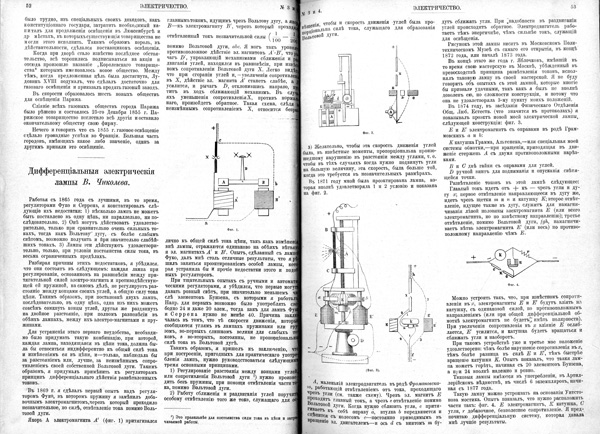
Articles in the journal "Electricity" about the differential lamp V.N. Chikoleva
N.N. Benardos invented the "Method of connecting and disconnecting metals by the direct action of an electric current", i.e. arc welding. The imperfection and low power of the arc power sources, the poor knowledge of the metallurgical welding processes required several more years of hard work from Nikolai Nikolayevich on a new method of joining products. As a result, the world's first welding unit was created from an electric generator and a battery of own design, switches, holders, and a technology for welding steel, copper, bronze, and cast iron was developed. In 1885–1887 to the “method of connecting and disconnecting metals with an arc”, called by the author “electrogefest”, N.N. Benardos received patents from Russia, France, Belgium, Great Britain, Austria-Hungary, Sweden, Italy, Germany, USA, Norway, Spain, Switzerland. Patenting abroad was financed by a merchant, the owner of tenement houses in St. Petersburg and Warsaw, S.A. Olshevsky (sometimes Olshevsky is considered a co-author, although in reality he was only a co-owner of patents).
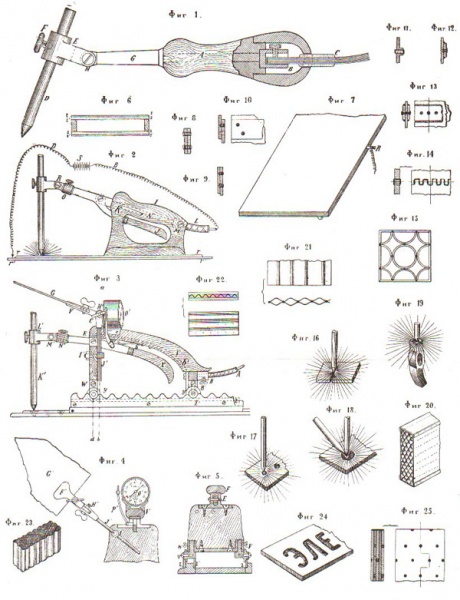
Drawing on the privileges of Russia No. 11982, issued in the name of N.N. Benardos
Benardos himself only had enough money to patent the invention in Russia at the Department of Trade and Manufactories, the privilege for the invention was received on December 31, 1886. In 1886, the world's first welding company, Electrogefest, was organized in St. Petersburg. She quickly gained worldwide fame. Industrialists from many countries, owners of companies producing steam locomotives, boilers and other products, came to Benardos to get acquainted with the new technological process. They were convinced of its effectiveness and quickly introduced innovation in their enterprises. The inventor himself organized welding production not only at factories in Russia, but also in London, Paris, Barcelona. By the end of 1887 in Russia, countries Western Europe and the USA already had more than 100 welding posts. Along the way, Benardos invented a method of resistance spot welding, hydro-electric melting, a powerful battery.
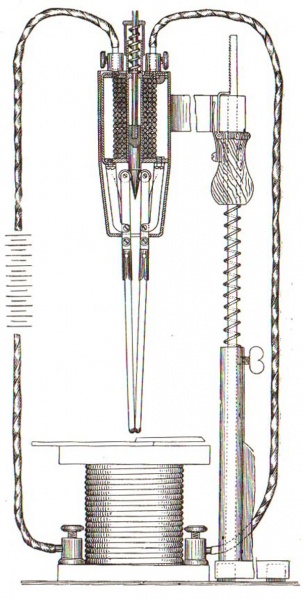
Device for welding with an indirect (independent) arc
In 1880, the Electrotechnician Association applied to the St. Petersburg City Duma with a proposal to light Nevsky Prospekt with electricity. It took more than two years for all the approvals, only in August 1882 the City Council concluded an agreement with the Partnership for the lighting of Nevsky Prospekt in the section from the Admiralty to Anichkov Bridge. However, the lack of financial resources did not allow the project to be completed, and Karl Fedorovich Siemens, having large capital, used the initiative of Russian technical circles, bought up the entire network and lights installed by the Electrotechnician Partnership, and organized electric lighting on the main street of the capital. After testing, from December 30, 1883, Nevsky Prospekt was finally illuminated with 32 lanterns (arc lamps) with a light intensity of about 1200 candles. Two power plants: one on a wooden barge on the Moika River near the Police (now Green) bridge with 3 locomotives and 12 dynamos direct current with a capacity of 35 kilowatts, the other - near Kazanskaya Square with 2 locomobiles and 3 dynamos, were serviced by a staff of 30 people. The "Office for Lighting Nevsky Prospekt with Electricity" began to operate. Thus, by the mid-1880s. The trading house "Siemens and Halske" carried out work not only on electric lighting of Nevsky Prospekt and adjacent streets, but also on a number of houses of the capital's aristocracy.
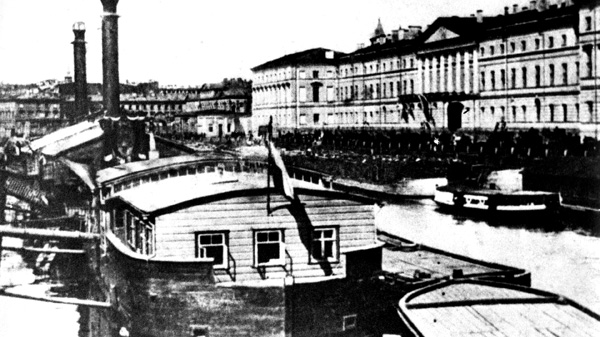
Power plant on a barge, r. Washing
Karl Siemens acquired a license for the use of Edison lamps in Russia and built a factory in St. Petersburg for the production of appropriate equipment - cables, lamps, switches, etc. In addition to it and the factory for the manufacture of telegraph and telephone equipment, Karl Siemens decided to build a dynamo plant in St. Petersburg, which would produce high-power electric motors, as well as turbogenerators and transformers.
The plant was named "Siemens-Schuckert" and was built in 1912.
The obvious advantages of electric lamps prompted experts to look for ways to replace gas lighting in the Winter Palace and adjacent halls of the Hermitage. Engineer Vasily Petrovich Pashkov, a palace administration technician, proposed as an experiment to use electricity to illuminate the palace halls during the Christmas and New Year holidays of 1885. The experiment was a success. On November 9, 1885, the project for the construction of an "electricity factory", involving the use of only domestic equipment, was approved by the Highest, with the note: "The winter balls of 1886 (January 10) should be fully illuminated with electricity." The work was entrusted to V.P. Pashkov. To exclude the possibility of vibration of the building from the operation of steam engines, the power plant was placed in a separate pavilion made of glass and metal. It was located in the second courtyard of the Hermitage, since then called "Electric".
The station building with an area of 630 m² consisted of an engine room with 6 boilers, 4 steam engines and 2 locomotives and a room with 36 electric dynamos. The total power reached 445 hp. The first part of the ceremonial premises was lit up: the Anteroom, Petrovsky, Big Field Marshal's, Armorial, St. George's Halls, and outdoor illumination was arranged. Three lighting modes were proposed: full (holiday) lighting five times a year (4888 incandescent lamps and 10 Yablochkov candles); working - 230 incandescent lamps; duty (night) - 304 incandescent lamps. The station consumed about 30,000 poods (520 tons) of coal per year.
On July 16, 1886, the industrial and commercial "Society of Electric Lighting" was registered in St. Petersburg. This date is considered to be the date of foundation of the first Russian energy system.
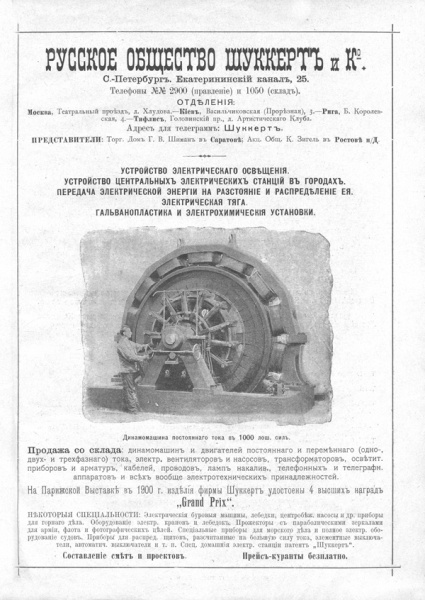
Among the founders were Siemens and Halske, Deutsche Bank and Russian bankers. Since 1900, the company has been named the Electric Lighting Society of 1886. The purpose of the company was designated according to the interests of the main founder Karl Fedorovich Siemens: “To illuminate streets, factories, factories, shops and all kinds of other places and premises with electricity” [Ustav…, 1886, p. 3]. The society had several branches in different cities of the country and made a very large contribution to the development of the electrical sector of the Russian economy.
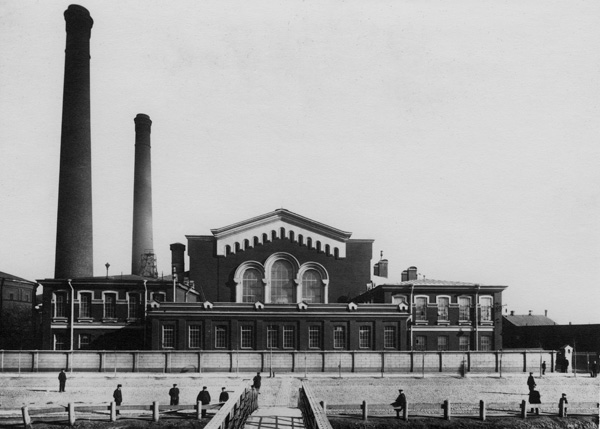
The building of the Central Power Plant of the Electric Lighting Society, 1886
On August 25, 1890, the Tsarskoselskaya electric station was organized, which became the result of the reconstruction of the DC lighting installation that had existed since November 1887. In 1887, when installing a water supply system, the idea arose of using steam engines not only to drive pumps, but also to drive dynamos. According to the project of engineer Pashkov, 120 lanterns (arc lamps) were installed on the streets of the city on cast-iron poles - for street lighting, the following were lit: the highway from Tsarskoye Selo to Yam-Izhora (at a distance of 4 versts), the Alexander and Spare Palaces, the barracks of the Life Guards hussar regiment and other buildings. The water supply was served by two water towers, respectively, there were two electric stations. Initially, 9 dynamos were installed at the stations. In the course of operation, the Tsarskoye Selo installation was constantly developing. The length of the air network, which was 60 versts in 1888, increased significantly after 1890.
In 1890, the reconstruction of the station began with the aim of full electric lighting of Tsarskoe Selo, and on August 25 of the same year a new unified AC power station with a voltage of 2400 V was officially opened. After the installation of an AC dynamo, reconstruction electrical installation and the device of a new 2000 V alternating current network, Tsarskoye Selo became the first city in Europe “which is completely and exclusively illuminated by electricity,” as S. N. Vilchkovsky wrote.
At the World Electrical Exhibition in Frankfurt am Main, M.O. Dolivo-Dobrovolsky demonstrated the world's first three-phase power transmission system over a distance of about 170 km. In 1919 M.O. Dolivo-Dobrovolsky put forward the position that the transfer electrical power alternating current over long distances (hundreds and thousands of kilometers) will be irrational due to significant losses in the line.
In 1893, retired colonel - engineer N.V. Smirnov turned to the mayor of St. Petersburg with a request to allow him to establish a Central Power Plant (CES) on Vasilyevsky Island "with the right to run overhead cables from it through the streets and use electric currents voltage up to 2000 V". The CES with an estimated capacity of 800 kW was launched on December 21, 1894 and was located on line 12 of V.O. (d. 15). 6 Babcock-Wilcox water tube boilers were installed in the boiler station. The engine room was equipped with 4 vertical compound steam engines with a capacity of 250 hp. with a steam pressure of 13 atmospheres. Machines similar in power and type only appeared and represented the latest technology. As a result, the technical and economic indicators of the station were incomparably better than the corresponding indicators of other power plants.
Station engineer N.V. Smirnov became a model for central power plants of this size and continued to exist throughout the first decade of the 20th century, serving as a model of a new type of urban central power station even after the transition to three-phase current high voltage.
Under the leadership of Russian engineers V.N. Chikolev and R.E. Klasson for the power supply of the Okhtensky powder plant in St. Petersburg, the first industrial hydropower plant in Russia with a capacity of about 300 kW was put into operation. The Okhten plant became one of the first industrial consumers of electricity. From the middle of the XVIII century. the largest industrial enterprise in St. Petersburg, the Okhtensky plant was considered well equipped and sufficiently mechanized due to water energy, regulated by its own dam on the Okhta River.
Chronology of events:
1877 - V.N. Chikolev carried out in the workshop of prismatic processes a pilot plant for optical crushing of light: the sewerage of electric light through pipes with mirrors from a powerful source of electric light (arc lamp). Experiments were also carried out with electric lighting by means of reflectors over long distances (up to 4 km). These works were necessary to ensure work at night and in the evening.
1879 - the plant was one of the first factory enterprises to use Yablochkov's candles for lighting.
1883 - incandescent lamps were used for outdoor lighting of the powder town. 90 lamps were located along the perimeter of the town with a length of about 6 km.
In the early 1890s At the plant, the task arose to combine the individual elements of the electrical economy, to move from private electrification of the plant to full electrification with the provision of electricity to all workshops of the plant.
1890 - new workshops were built, which are fully equipped with electric lighting. The work carried out on a large scale was carried out in two stages: first, they installed 2 dynamos with a capacity of 40 kW, a battery with a capacity of 500 Ah from 120 batteries and 550 incandescent lamps, as well as a 9 hp DC motor, and carried out the transmission energy to him. The work was carried out between September 1890 and May 1891. The work of the second stage consisted of installing a 40 kW dynamo and 400 incandescent lamps, as well as installing electrical signaling in new workshops. The duration of work on the second stage was one and a half years. V.N. was invited to supervise the work. Chikolev, first as a foreman, and from 1892 as an electrical engineer of the plant.
In the winter of 1895, an electric railway began to function for the first time in St. Petersburg - a route from Winter Palace to Mytninskaya embankment was laid on the ice across the Neva. The tram was built by the Russian electrical company M.M. Podobedova. Giving a sketch of this tram going across the Neva, an illustrated magazine of that time wrote: “The speed and convenience of communication, as well as the cheapness and novelty of this kind of movement, attract a lot of passengers, and the new enterprise is undoubtedly not only convenient for the public, but also not without benefits for entrepreneurs. It's a pity that the electric railways, which in many cities have successfully replaced the obsolete horse cars, have not yet acquired the rights of citizenship and wide distribution from us. We must, however, hope that in our country, not only across the Neva, but also along the streets, electric “horses” will eventually go.
The St. Petersburg City Self-Government entered into concession agreements with three companies: the Electric Lighting Society of 1886, the Helios Society and the Joint Stock Anonymous Belgian Society for the construction and operation of power stations and network facilities.
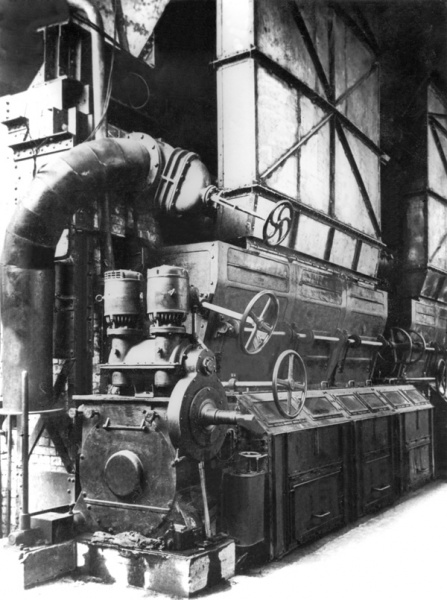
The furnace of the coal boiler of the Central Power Plant of the "Belgian Anonymous Society for Electric Lighting of St. Petersburg"
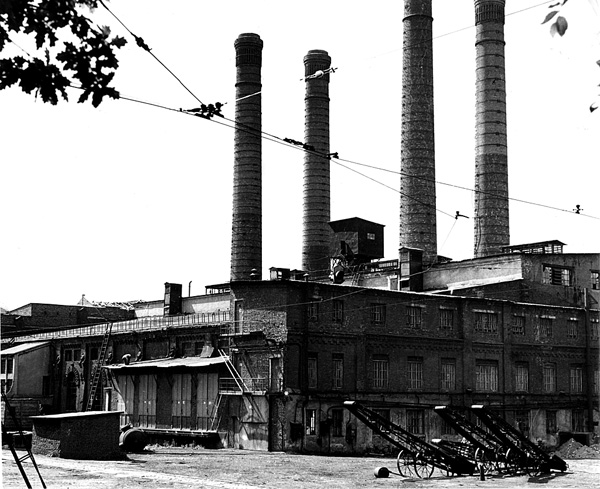
The building of the Central Power Plant of the "Belgian Anonymous Society for Electric Lighting" - CES of the "Belgian Society"
The central power plant of the Joint Stock Company "Helios" from Cologne was built in the Rozhdestvenskaya part of St. Petersburg (Novgorodskaya st., 12-14). Having received a profitable and convenient site that provides an abundance of water, the cheap delivery of cars, building materials and coal by water, the Germans launched a stormy activity. In a short time, Russian workers erected the main structures, and on April 27, 1897, the power plant gave industrial current. The engine room building and the front building of the plant management attached to it were built according to the project of civil engineer-architect V.A. Flight. Initially, 7 boilers were installed and 4 steam engines of 1000 hp were installed. with generators single-phase current 3000 V each. A year later, 3 more machines and 6 boilers were put into operation. The installed capacity of the station was 5250 kW.
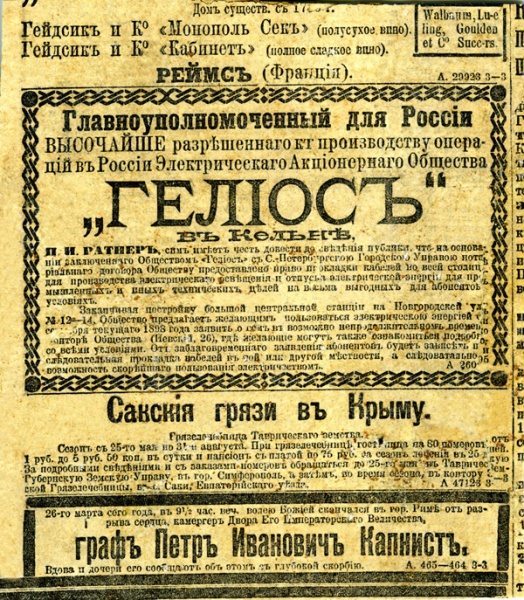
The text of the announcement of the Helios Society in St. Petersburg newspapers
The central power station of the Belgian Anonymous Electric Lighting Society (104, Fontanka River Embankment) was built in 1897–1898. The German firm "Schmatzer and Gue", which received a concession for fifty years and a building permit, subsequently appears as the "Belgian Anonymous Society for Electric Lighting" and operates under the patronage of the Belgian Military Mission.
The first steam engine with a capacity of 350 kW was put into operation on May 22, 1898. Three years later, 18 steam engines with a total capacity of 5500 kW were already operating at the station, and in 1903 the first Parsons steam turbine with a capacity of 680 kW was installed here.
In 1897–1898 the Central Power Station of the Electric Lighting Society of 1886 was built (Obvodny Canal, 76). On November 16, 1898, the station was put into operation in a festive atmosphere. Four steam boilers and six steam engines were put into operation, the total power of which was 4200 kW. Siemens and Halske supplied equipment for the Central Power Plant of the Electric Lighting Society of 1886 (CES "OEO 1886"). More than a hundred people worked at the power plant at that time. Seven small power stations, which belonged to the Electric Lighting Society of 1886, were closed after the launch of the CES, and all subscribers were transferred to the buses of the new station.
The Novoye Vremya newspaper dated November 9, 1898 wrote: “Yesterday, the cable brought to the network of Gostiny Dvor launched energy from the station on the Obvodny Canal and lit up the shops, i.e. Instead of the station on Kazanskaya Square, Gostiny Dvor was illuminated from the Central Power Plant. In 1916, there were nine turbines and eight steam engines in the station's engine room, with a total installed capacity of about 49,000 kW. More than half of the electricity consumed by Petrograd at that time was generated by the CES.





